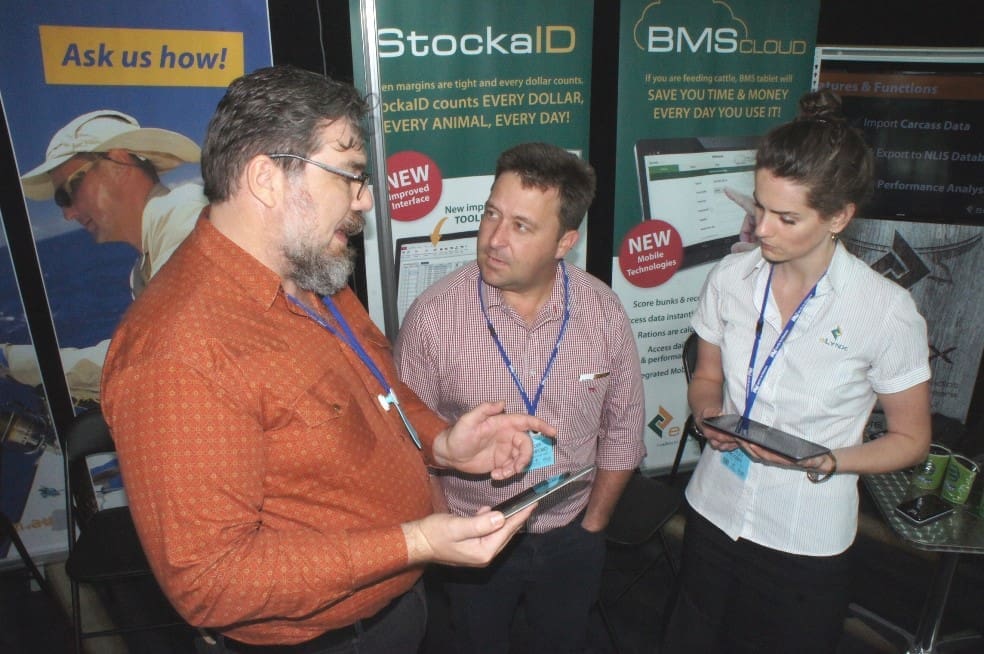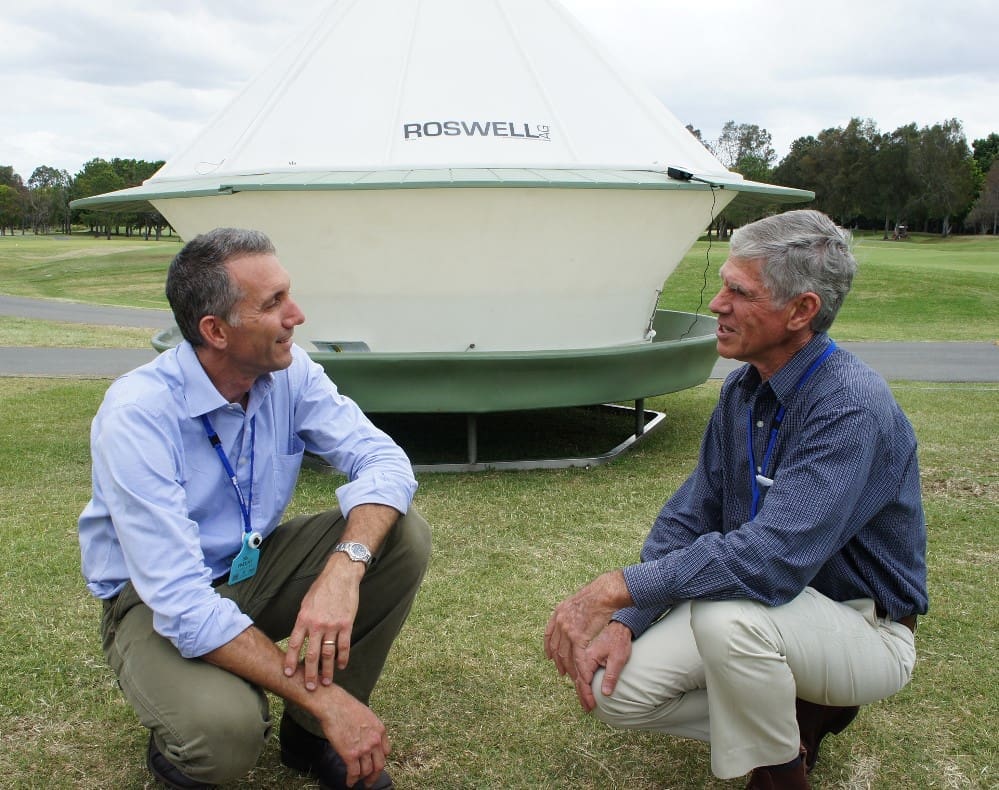Efficiency and productivity were the keys in a range of new and improved products and services on show at the BeefEx feedlot conference on the Gold Coast recently. Here’s a quick snapshot of some more items that caught Beef Central’s attention among the commercial exhibits…
New software offers attractive entry-point for smaller feedlots
Software developer Elynx was on hand at BeefEx to showcase two new feedlot-oriented products in its toolkit.
While the company already has management software solutions operating in an estimated 80 percent of all large feedlots in Australia, it is in the smaller to medium-sized feedlot sector that its new products, StockaID Lite and BMS Cloud have been developed.

Wainui feedlot’s Geoff Cornford, with Hayley Roseby and Gavin Knight from Elynx during BeefEx. Click on images for a larger view.
Elynx has released new and simplified web-based and lower-cost software versions to allow smaller grainfeeding operations, typically up to about 6000 head, to access similar management systems that the big operators use. The two new systems overlap and work well together.
Elynx has used a new design approach that centralises and simplifies the software itself, as well as its installation and use. The company has also launched a new pricing model, based on feedlot size, that also enhances attractiveness to smaller operators.
Seen for the first time at BeefEx was Stockaid Lite, a new lower-cost and simplified version of its popular Stockaid product, which manages individual costs, statutory and QA requirements like NLIS and NFAS accreditation down to the individual animal level to provide lifetime traceability.
It is supported by not only a pre-configured database, but hours of online training to reduce the need for onsite service and setup costs.
Elynx’s Bunk Management System (BMS) has also been revamped for smaller feedlot use in the form of ‘BMS Cloud’, which provides a mobile, tablet-based multi-user operational management system for feeding and commodity management. It handles feeding regimes, commodity management and performance monitoring cattle by lot or pen.
Over the past six months since launch, a number of smaller commercial feedyards have installed and road-tested the new StockaID Lite and BMS Tablet software, with positive feedback. The 2500 head Melbrig feedlot near Mundubbera, in Queensland’s North Burnett region, estimated that it saved ten hours a week in stock and feed/commodity management since installation. Similar positive responses have been received from mid-sized feedlots in WA.
Gavin Knight, technical director at Elynx, said the company was moving to a per-head subscription model for its new software products, and would carry that model through other products, including the full version of StockaID and FY3000, as new versions are released.
“In much the same way as your i-phone automatically updates with new software, the tablet version of BMS Cloud will do the same thing,” Mr Knight said. “We will be able to continuously update and improve the product over time, and these upgrades will automatically be sent to subscribers,” he said.
Another big step in the function of the software systems is a decision to move to a ‘workflow’ type paradigm, which is saving operators time, effort and money.
Previously for feedlots that were not large enough to justify investment in eLynx’s full version of StockaID, spreadsheets were commonly used, or in some cases, users have attempted to adapt paddock-based software programs for feedlot use, with various degrees of success.
“It’s the first time a dedicated software solution has been delivered for operators at this scale, because we recognise the future of this marketplace. There’s a lot more of them operating at this scale across Australia, and they show high degress of specialisation, ranging from Wagyu to shortfed domestic feeding.”
“We are starting to see the potential for those yards to again be profitable, and our products support that,” Mr Knight said.
- Click here for more details: http://www.elynx.com.au/stockaid-lite
Circular self-feeder offers ‘out of this world’ performance
IT looks like a flying saucer, but the aptly-named Roswell circular self-feeder offers a range of down-to-earth advantages over conventional rectangular livestock self-feeding stations.
Unlike the familiar gal-steel double-sided rectangular paddock self-feeders, the Roswell RCF 9500 units seen at BeefEx recently for the first time, are made from moulded poly and stainless steel, eliminating rust.

Veteran feedlot consultant Len Perry, right, looks over the Roswell self-feeder displayed at BeefEx with its designer and developer, Bill Findlay from Roswell Ag
The flexible poly construction means the unit will also ‘bounce back’ if hit by a vehicle or piece of machinery, rather than bending out of shape like steel units can.
The various moulded segments all disassemble, making it easy to take apart and relocate to a new paddock or location. It also means that up to 10 units can be stacked, one inside the other, for convenient and cost-effective transport.
A semi-load can easily accommodate two stacks of ten units.
Why the round design? Bill Findlay from Roswell Ag says there are a number of advantages, not the least of which is that the shape allows more cattle to feed at one time. Up to 30 average sized cattle can access ration simultaneously, and there are no blind spots at the corners.
The central storage hopper contains a 45-degree angled cone, which provides the ‘fall’ necessary to keep the feed flowing to the outlet access area, using anything from a grain-based ration to cottonseed. The rate of feed delivery is infinitely adjustable, via turnbuckles attached to the circular skirt.
Nor are there any internal structures for feed to get hung-up on.
The bunk feeding area is well-covered with overhead weather awnings, but has regular drainage slots to drain any blown-in moisture.
Each unit holds 9.5 cubic metres of feed, or about 50 percent more than a conventional double-sided paddock self-feeder. The poly sides of the unit are translucent, meaning the operator does not have to climb ladders to check feed levels.
Most self-feeders are priced at about $1000 per tonne of feed capacity, and the Roswell units follow that formula. With a capacity of 5.7 tonnes of feed, each unit costs around $5700.
- Click here for more details: http://www.roswellag.com.au/#!cattle-feeder-product/cee5
